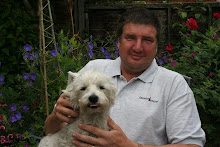OK - I'll come clean! This is not some tale of anti-hero outlaws extracting violent revenge on the Bank of Ireland for their cheque book charges, fat-cat bonuses or other wrongs; this is a genuine earth bank. Regular readers will have met it before as the place of rest of the horse-drawn hay rake and the site of our disinterment of the rusty metal fertilizer spreader. It runs along our western boundary 'under' the hedge which divides us from Vendor-Anna's 5 acre field. It is a mess. We can only assume that for 30+ years (easily more) TK Max and TK Min used it as a dumping ground for farm junk.
The hawthorn hedge which was there is now easily 50 years old and has long since been pushed through by elder trees. The elders have dropped branches, as they do, and these have been grown up through by ancient and venerable stinging nettles. Old fashioned peat-turfs have been piled against the hedge - the old "hand-won" shape cut with a "slean" (pronounced 'shlee-un' ish); a long narrow spade with a knife coming off one side at 90 degrees to give you an L-shaped cut. These have either been deliberately or accidentally covered with black silage-bale wrap, entombing them (so at least they are dry-ish!) before topsoil has been bulldozed (?) against and over them to make the bank. Big round bales of hay have at some stage been leant against this.
You'll know that we have worked really hard here since moving in battling with various bits of the garden, cutting down tall stuff, mowing, pruning and generally trying to force it to be a garden rather than a jungle, but 'The Bank' we have to admit, has been a bit neglected. The Bank looms over us like a dark cloud, clearly visible from the big pond, the pond garden and the orchard. Its thickets of stinging nettles rise up from the rotting hay-bales and the Queen Anne's Lace (Cow Parsley) tries to out-height the unkempt hedge. The holes we have made extracting the spreader and un-burying the hay rake look like tiny, pathetic breaches in the curtain-wall of a castle.
Now, though, I am done pond-digging and I am on top of weeding in the 'allotment', so I have decided to add it to my 'hour-a-day-whatever-the-weather' job list, the not-so-pleasant tasks I make myself do in order to earn the more pleasurable jobs or a rest or a cup of coffee! Liz is also involved and gets stuck in when she can. It is hard, heavy and frustrating work because you just can't get a shovel down through the nettle roots, baler twine, plastic wrap and bits of tree.
The only way to beat it seems to be to rip into it with a pick axe, pulling loose tufts of root and then going through it by (gloved) hand sorting what you can get loose into types and degrees of usefulness - hay and green weeds to the compost, metal, twine, wrap and nettle root to the non-recycle bin, stones and rocks to the reserve rock pile, wood and turf sods for burning if big enough and that lovely top soil onto various new beds. By slow degree we will dismantle the bank dropping its level to one of 'raised bed near hedge' and un-ship all the rubbish. It is hot work, as I said, and the 9-week old chickens quickly adopted the bare crumbly top soil I am exposing, for dust bathing. Watch this space for progress.
Meanwhile, as I also said, the allotment bit is under control and I am delighted with it. It is better looking and more productive, seemingly, than any attempts I made in Kent (I have loads more time here) and is streets ahead of last year's flat cultivation, washed out, as it was, by the masses of rain and prey to crop failures all around. I have today been able to pick some first over-wintered broad beans.
These bushes were almost completely wiped out by the terrible drying east winds which blew for 3 weeks continuously in Feb/March but have recovered well and are now 3 feet high and covered in pods low down on each stem. The pods are not as full as I would like as there were very few bees about back when these guys were in flower, but that is the kind of thing we will help as we get more into the 'wildlife garden' side of things - the self seeding insect friendly flowers and so on.
To this end, a huge Thank You to a Facebook friend who has picked up the nickname (on FB) of 'Backchat Black'. He lives in Spalding (Lincs) and is mad keen on this kind of gardening and has posted me seeds of teasel, comfrey, pot marigold, tansey and feverfew. Also to Pud Lady who is sending me regular supplies of the free gift seed packets which come with subscriber gardening magazines. Between us we should achieve a riot of colour and a heady buzz of insects. The photo (left) is of a common spotted orchid now appeared in our orchard meadow. We are on the starting ramp.
Saturday, 29 June 2013
Attacking the Bank with a Pick Axe
Labels:
Back Chat Black,
Cheque book,
common spotted orchid,
Pick Axe,
silage bale wrap,
Slean,
TK Max,
TK Min
Subscribe to:
Post Comments (Atom)









No comments:
Post a Comment